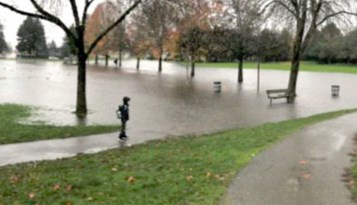Last week’s rain storm — the atmospheric river that swept across southern B.C. and had Richmond pumping almost a million gallons of water per minute — is what scientists call a “black swan,” something so rare it catches everyone off guard.
Steveston resident John Roston was sounding the alarm this week about the height of Richmond’s dykes, worried whether the city is working fast enough, especially given sea levels are rising faster than in the last century.
This is particularly troubling for him as he lives just a few hundred metres from the Fraser River.
While the city is focused on raising the dykes about a metre in anticipation of sea-level rise rates in 2100, Roston wants to see the focus on the two metres that it’s expected to rise over the next two hundred years. In fact, worst-case scenarios from scientists say two metres could be achieved by the end of this century.
“Even two metres instead of one metre has a profound impact for Richmond,” Roston said.
However, as city spokesperson Clay Adams pointed out, the city’s timeline for raising dykes by about a metre has been moved up by 25 years.
Furthermore, he clarified, the city is “constantly monitoring emerging climate data and updating the plans accordingly.”
City Coun. Carol Day responded to Roston’s concerns saying she’s confident the accelerated dyking plan reflects “where we need to be.”
Day said she has reports “up the wazoo” about the work the City of Richmond is doing, for example, building super dykes on Duck Island and planning a new dyke on Sturgeon Banks.
“Climate action is on top of everybody’s mind right now… (but) it doesn’t serve any purpose to raise alarms without looking at what’s already being done and the steps that are in process right now,” Day said.
She added, though, she takes concerns from Richmond residents seriously, but she’d also like to see the city do more to let Richmondites know about the work being done on the dykes.
Roston said he’s not surprised by the reaction from Day, but much of the information he has is from city staff’s own reports.
Roston experienced another “black swan” — the ice storm that hit parts of Quebec and Ontario in 1998, and he remembers the lack of preparedness and the nonchalance of his many Montreal neighbours when tree limbs started falling off their trunks under the sheer weight of the ice.
Like the torrential rain in B.C. last week that devastated Abbotsford, ripped through a dyke in Princeton, washed out chunks of the Coquihalla and Highway 7 and inundated the wastewater system in Merritt, no one seemed to think it was possible in Montreal for freezing rain to fall for 80 straight hours, crippling cities for days and sometimes weeks.
“A lot of the things we imagined were impossible, or close to impossible, happened,” Roston said.
Presenting citizens with the worst-case scenario won’t cause them to panic if it’s accompanied with a plan of action, said Roston.
“Include in your message, ‘you’re not going to drown,’” he said.
During last week’s three-day storm, the city’s 39 pumps along its 49 kilometres of dykes moved about 18 million cubic metres of water over three days in total.
This brought its system to 79 per cent capacity, moving 1.1 million U.S. gallons (924,000 Cdn gallons) per minute.
SFU earth scientist doesn't expect 'worst case scenarios'
John Clague, an earth scientist at SFU, doesn’t believe sea level rise will get to some worst case scenarios being presented.
Clague said earth is already “locked into a certain amount of warming” so some solutions are needed to mitigate its effects.
He encouraged Richmond residents to educate themselves on the drainage and dyking system, what it means for the preservation of Richmond and the cost to upkeep the system — something that’s beyond municipal budgets.
Clague said it’s prudent to “plan for the unexpected,” but maybe not for “the worst possible thing” because “there are many other demands on public funds, like housing, the opioid crisis… that really trump planning for the absolute worst thing that can happen to you.”
“But it doesn’t mean you can’t allocate public funds judiciously to correct obvious problems with infrastructure,” he added.
Sea level rise and earthquakes — both of which could cause catastrophic flooding in Richmond — are real risks to Richmond, so Clague believes citizens need to advocate for more protection but also think globally about reducing warming temperatures.
“Maybe they should get involved in those discussions as part of democracy,” Clague said.



